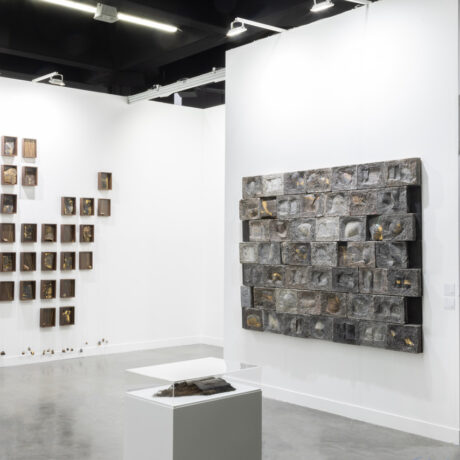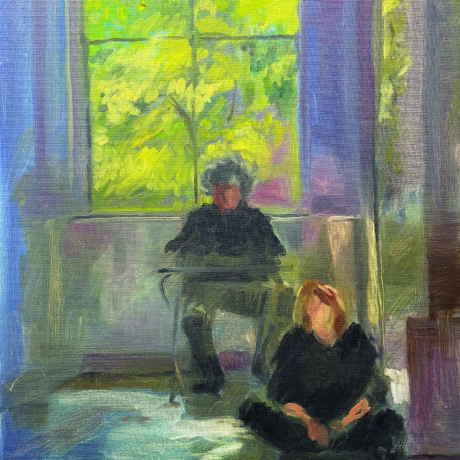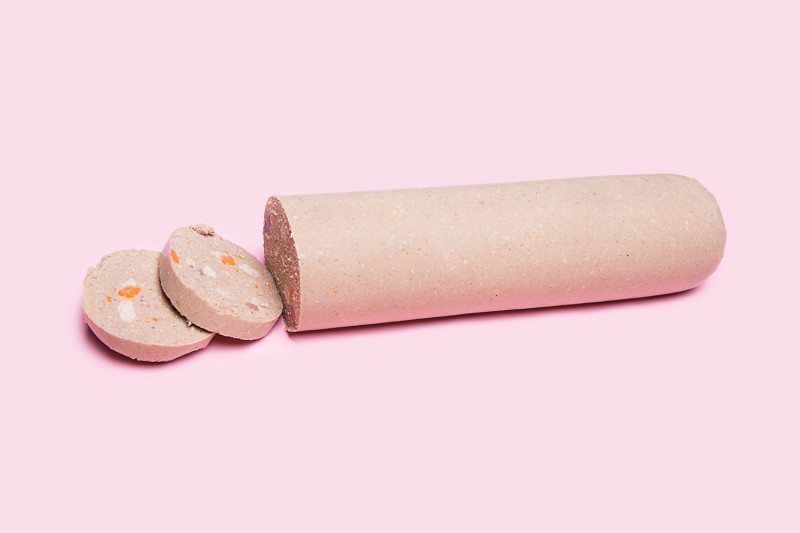

Eating as an entertainment and as a social ritual is also explored in Keith Coventry’s work. Exhibited in the summer at Pace Gallery London’s Today’s Specials show alongside the aforementioned Oldenburg and van Bruggen piece, Coventry’s Kebab Machine 2 pays homage to the British tradition of the boozy kebab. The artist elevates the customary post-pub munch to a new status in his sculpted, rotating bronze version of the kebab machine, poised atop a plinth. Like Friedman, Coventry’s junk-food habit is shot through with humour, and wistful nostalgia for the communal enjoyment of food, rather than criticism of our consumerist impulses.
Though this puckish handling of the theme seems to come predominantly from male artists, there are some female artists whose practices align with the interests of showing the absurd and comical side of this fast-food culture. Phebe Schmidt, a Melbourne-based photographer, uses some of the most commonly recurring food imagery in her work—milk, eggs, meat and cheese—but makes them bizarre, alien, plastic. Entrapment (Untitled) 2 depicts a chopped slab of processed sausage in high-definition. Scrutinized under the photographer’s lens, it looks neither edible nor repulsive but generic—it is clinical and at the same time prompts sexual associations.
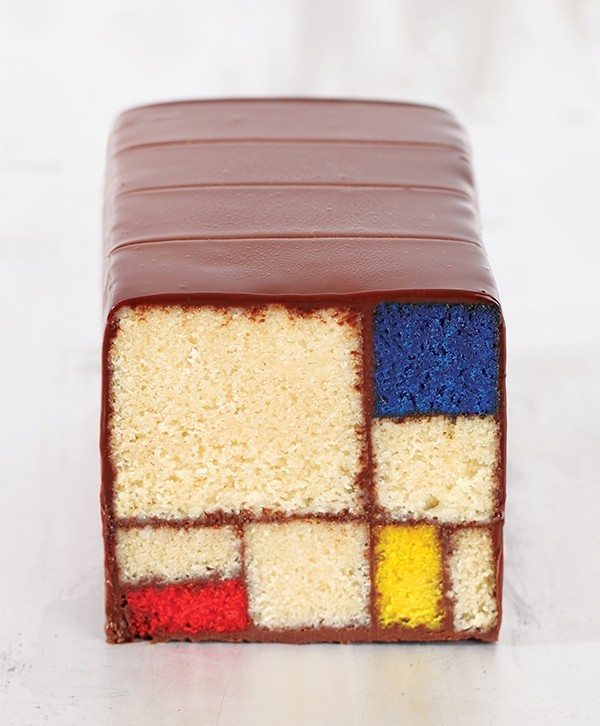
Schmidt tells me her aim is not necessarily to offer a critique of food ideology, but to manipulate its structure for its inherent material qualities: “I am interested in creating an alternate concept of what [food] can be—unattainable and artificial—rather than a form of substance or pleasure.” In the creation of art, there’s a shared dynamic between the chef’s kitchen and the fine artist’s studio as sites of creation, where a ‘product’ is rolled out for public consumption. Caitlin Freeman, whom I interviewed for this article, offers an intriguing analogy that sheds light on the way we engage with art in the consumer world. “The feelings I got [when viewing art in a gallery] most often were ones of wanting to own or consume the work.” The idea of ‘consuming’ art is perhaps self-evident, but the desire Freeman alludes to for ‘ownership’ says a lot about the modern psyche, and shows how relevant food is in the economic apocalypse. Food can be covetable and aspirational—yet at the same time it can also be extremely attainable and ordinary, at least for most of the developed world. If we cannot own intangible concepts or afford palpable luxury goods (such as highly priced artworks) we can appropriate them somehow through food.
Freeman’s book, Modern Art Desserts, makes famous art works literally edible. A photography graduate, Freeman’s café at SFMOMA served up creations such as the Winogrand Layer Cake—with a hidden speaker that played ‘Sir Duke’ by Stevie Wonder when eaten. Her Matisse Parfait was inspired by a portrait of Allan Stein with a bright pink background—with a long neck made out of a cylindrical frozen yogurt parfait atop a pink strawberry coulis (drawn from the painting’s background) and topped off with big chocolate curls to mimic Stein’s hair.
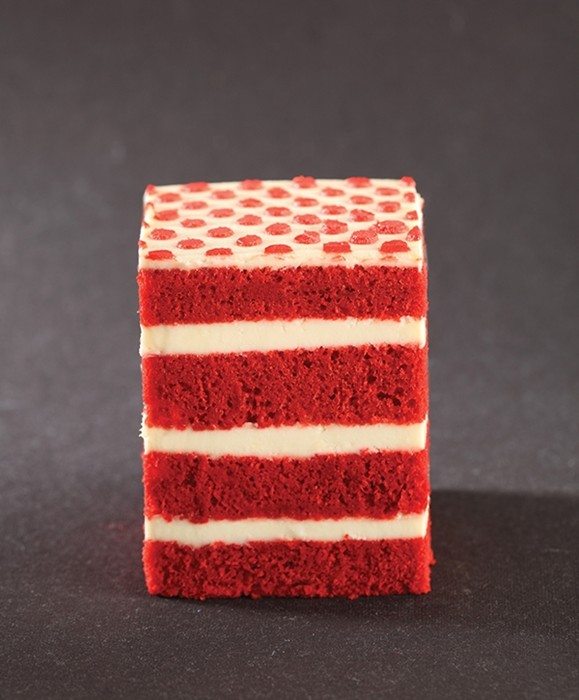
But there’s another side to the food dialectic. It is loaded with sociopolitical connotations and its revolting, ephemeral forms, colours and smells are just as appealing to artists working in experimental practices—sculpture, performance and video. Dieter Roth, with his rotting food sculptures, is an early exemplar of this movement. Dairy foods and meat in particular are prevalent because of their historic and religious importance, giving them a binary symbolism. But it’s not just the physical constitution of food that can be nauseating; the often gruesome and distasteful process by which it is mass-produced—and wasted—is a popular topic in contemporary art.
Working within the tension of the delight/disgust dialectic, video artist Mika Rottenberg has pioneered an experimental, visually rich perspective of the production line. In her video installations she chooses women as her protagonists, arranging them into pointless production chains: Cheese (2007) is a fairy-tale work, based loosely on a true story of the Seven Sunderland Sisters. Carefully styled to evoke many different aspects of an antiquated farming process—from handmade, clunking contraptions to the fresh-faced purity of women workers dressed in white who milk their floor-length hair to produce cheese.
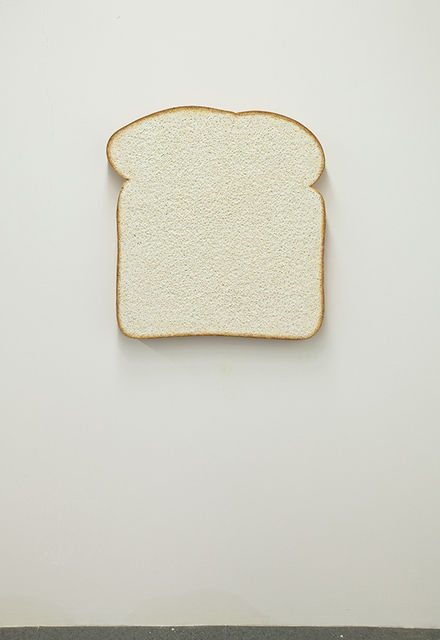
Making food manufacture equally bizarre is the futile labour as shown in Dough (2006) which stars the six-foot-four-inch, 600-pound-plus female pro-wrestler Queen Raqui; the textural quality of the fleshy rolls of dough mixture that drip thickly down to her basement room connote the extreme proportions of the worker. In portraying only women in her factory scenes—and often with extreme physical features— Rottenberg questions not only disgust brought about by an industry that produces to excess, but the flat branding of women’s work. It’s perhaps not surprising that most of the artists who react ambivalently to food or show its repulsive side are women.
While Rottenberg’s work is not just about feminism but a wider Marxist ideology, food does ascribe gender roles to women as the nurturer in the domestic setting, and the corollary is female artists react differently towards food. It’s become a form of societal control, a way to prescribe diet and beauty ideals in a health-frenzied world where eating disorders are pandemic. As such, a rebellion against food often manifests itself violently in works by female artists—something I’ve encountered in my own curatorial work. Picking up on the repeated mantra ‘breakfast is the most important meal of the day’, the binge/purge cycle is difficult to watch in Wyse + Gabriely’s video work Cereal (2013), where the artist shovels cornflakes into her mouth then forces herself to vomit into her bowl, and continues to force-feed herself the spew. In Porridge (2013), the artist empties the bowl over her head, creating a suffocating self-inflicted matrix. It’s a vivid, if uncomfortable, visual reaction to the pressure society imposes on women when it comes to diet and eating habits.
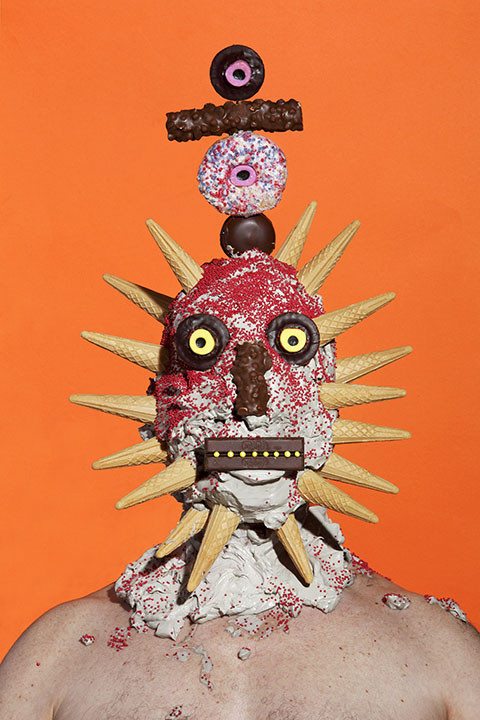
The Politics of Food at Delfina Projects in 2014 demonstrated the complex current issues implicit in food and the way society presents it. Megan Fizell, curator of the upcoming Mouthfeel exhibition at the Brenda May Gallery, Sydney, is dedicated to researching the use of food as a topic and medium in contemporary art. She explains: ‘In my opinion, the major difference in the handling of the theme by men and women is that men often utilize food in their work for the material’s specific characteristics whereas women regularly use food in order to harness the sociocultural associations linked to the material.’ Anja Carr, a performance artist based in Oslo who frequently uses food in her work to inspire a queasy sensory reaction, comments: “Food is this thing between living and dead. It can be a tool to explore the delicate border of seducing the viewer or make them disgusted. Like body waste, it easily changes meaning depending on the setting.”
James Ostrer uses food provocatively and personally as a reaction against sugar addiction, something Megan Fizell also explored in her Sugar Sugar group exhibition. Ostrer dumps layers of cream, candies and other demonized foods onto heads, creating lurid, horrible Frankenstein’s monsters. Wotsit All About, his latest exhibition at Gazelli Art House, was a nightmarish exploration of sugar addiction, showing powerfully how prescribed rules around diet and nutrition are bound up with self-image. Through food’s visual expressivity and ambivalence, it has become a glorious, immersive medium and vehicle for engaging with concerns about social conditions and behaviours, from globalization to gluttony. Whether they set out to whet our appetite or cloy our palette, it’s this key underlying dichotomy—between disgust and delight—that makes food an ever-relevant metaphor in art practice.
